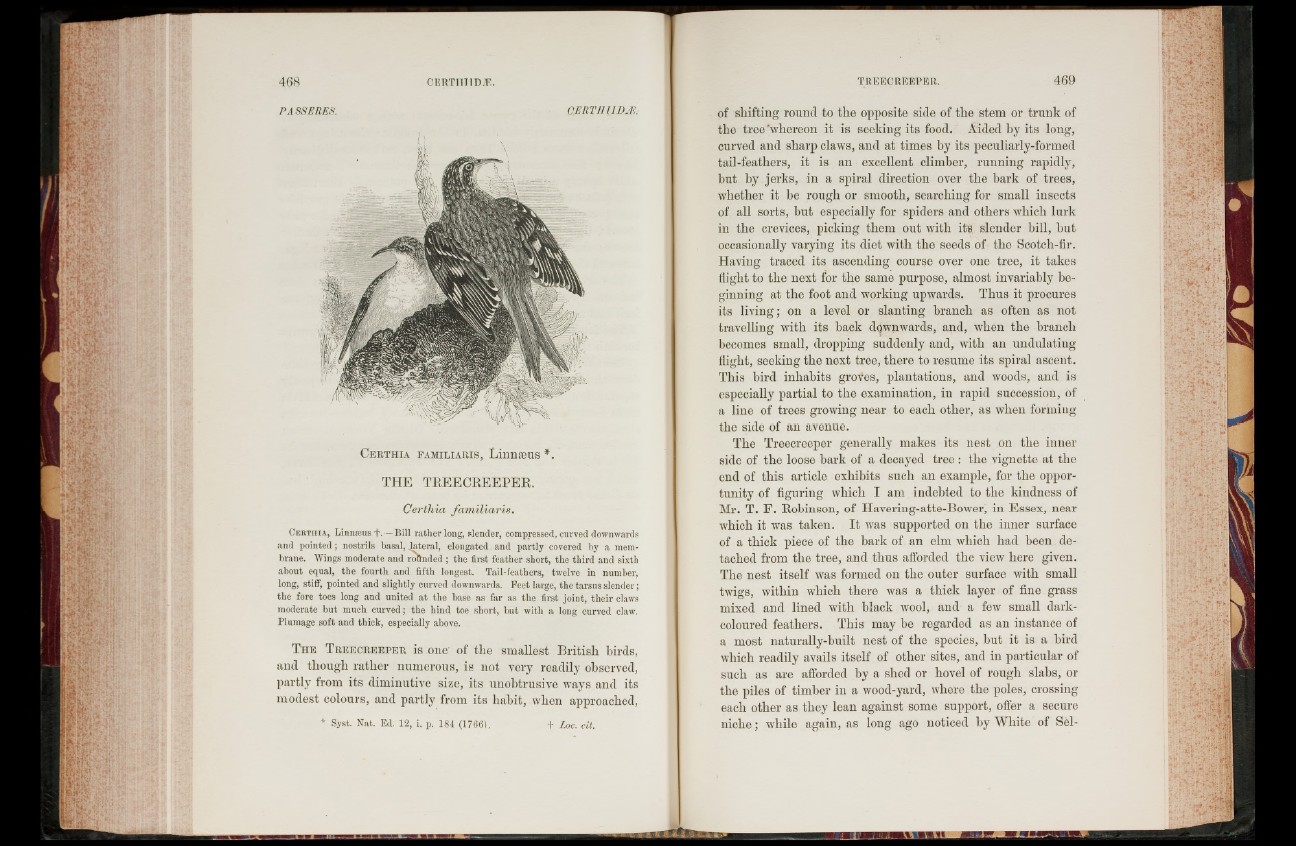
C e r t h ia f a m il ia r is , Linnaeus *.
THE TREECREEPER.
Certliia familiaris.
C e r t h i a , Linnreus f . — Bill rather long, slender, compressed, curved downwards
and pointed; nostrils basal, .lateral, elongated and partly covered by a mem-
brane. Wings moderate and roftnded ; the first feather short, the third and sixth
about equal, the fourth and fifth longest. Tail-feathers, twelve in number,
long, stiff, pointed and slightly curved downwards. Feet large, the tarsus slender;
the fore toes long and united at the base as far as the first joint, their claws
moderate but much curved; the hind toe short, but with a long curved claw.
Plumage soft and thick, especially above.
T h e T r e e c r e e p e r is one' of the smallest British birds,
and though rather numerous, is not very readily observed,
partly from its diminutive size, its unobtrusive ways and its
modest colours, and partly from its habit, when approached,
* Syst. Nat. Ed. 12, i. p. 184 (1766), + Loc. cit.
of shifting round to the opposite side of the stem or trunk of
the tree'whereon it is seeking its food. Aided by its long,
curved and sharp claws, and at times by its peculiarly-formed
tail-feathers, it is an excellent climber, running rapidly,
but by jerks, in a spiral direction over the bark of trees,
whether it be rough or smooth, searching for small insects
of all sorts, but especially for spiders and others which lurk
in the crevices, picking them out with its slender bill, but
occasionally varying its diet with the seeds of the Scotcli-fir.
Having traced its ascending course over one tree, it takes
flight to the next for the same purpose, almost invariably beginning
at the foot and working upwards. Thus it procures
its living; on a level or slanting branch as often as not
travelling with its back downwards, and, when the branch
becomes small, dropping suddenly and, with an undulating
flight, seeking the next tree, there to resume its spiral ascent.
This bird inhabits groves, plantations, and woods, and is
especially partial to the examination, in rapid succession, of
a line of trees growing near to each other, as when forming
the side of an avenue.
The Treecreeper generally makes its nest on the inner
side of the loose bark of a decayed tre e : the vignette at the
end of this article exhibits such an example, for the opportunity
of figuring which I am indebted to the kindness of
Mr. T. F. Robinson, of Havering-atte-Bower, in Essex, near
which it was taken. I t was supported on the inner surface
of a thick piece of the bark of an elm which had been detached
from the tree, and thus afforded the view here given.
The nest itself was formed on the outer surface with small
twigs, within which there was a thick layer of fine grass
mixed and lined with black wool, and a few small dark-
coloured feathers. This may be regarded as an instance of
a most naturally-built nest of the species, but it is a bird
which readily avails itself of other sites, and in particular of
such as are afforded by a shed or hovel of rough slabs, or
the piles of timber in a wood-yard, where the poles, crossing-
each other as they lean against some support, offer a secure
niche; while again, as long ago noticed by White of Sel-
Te TTl!